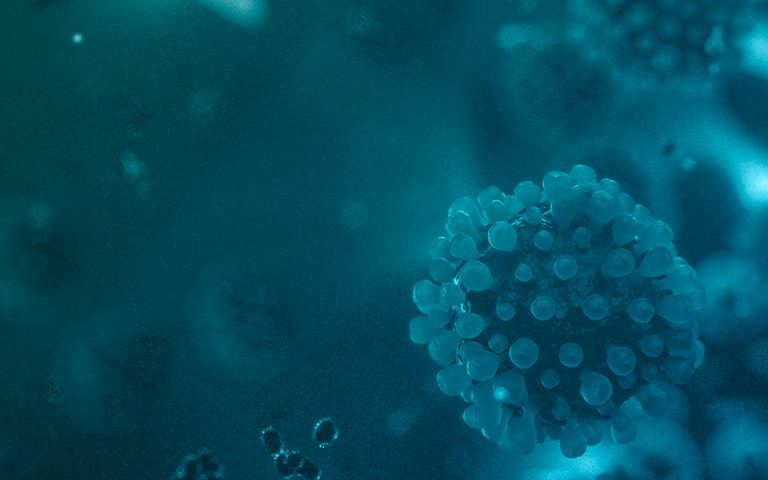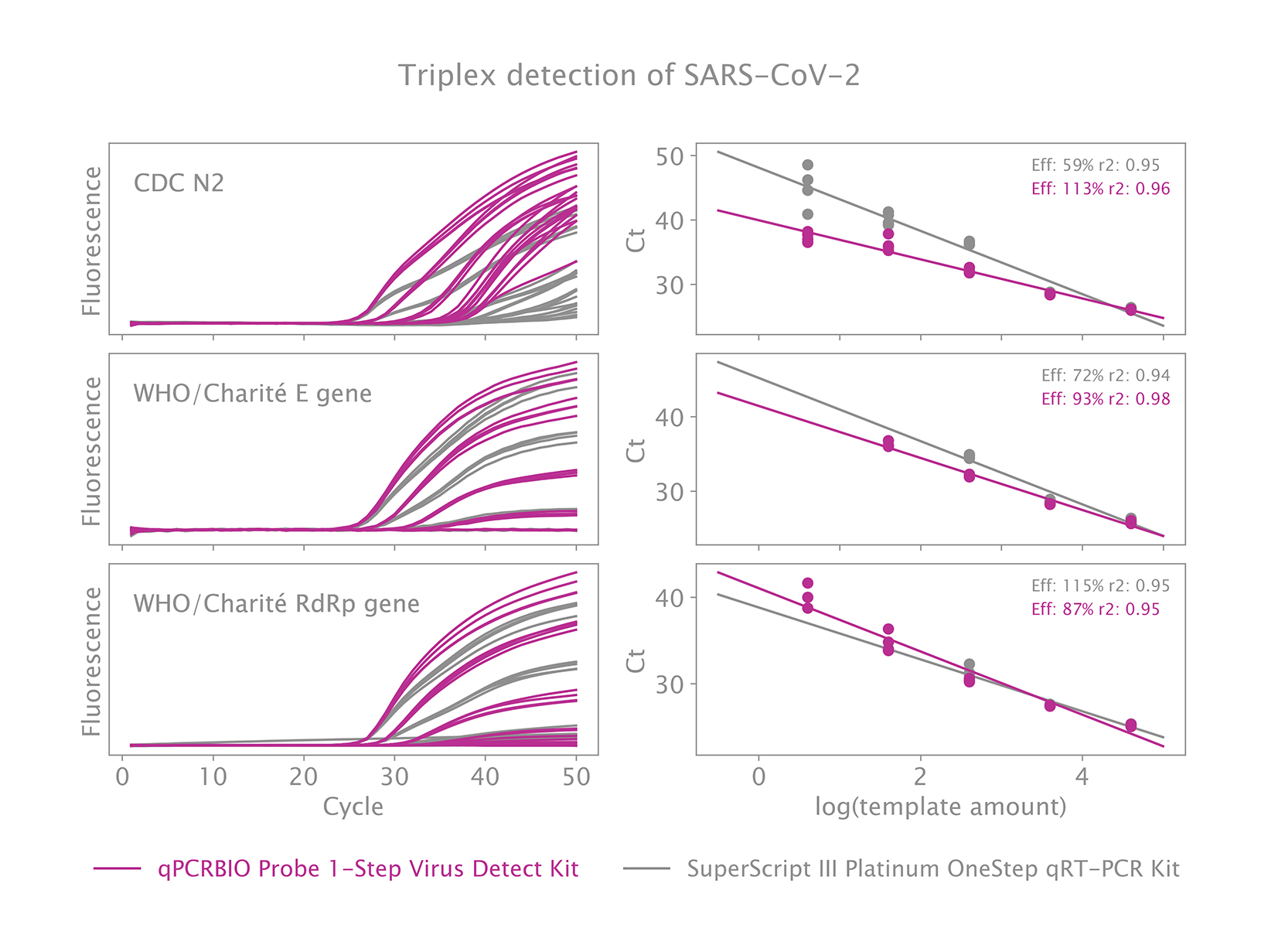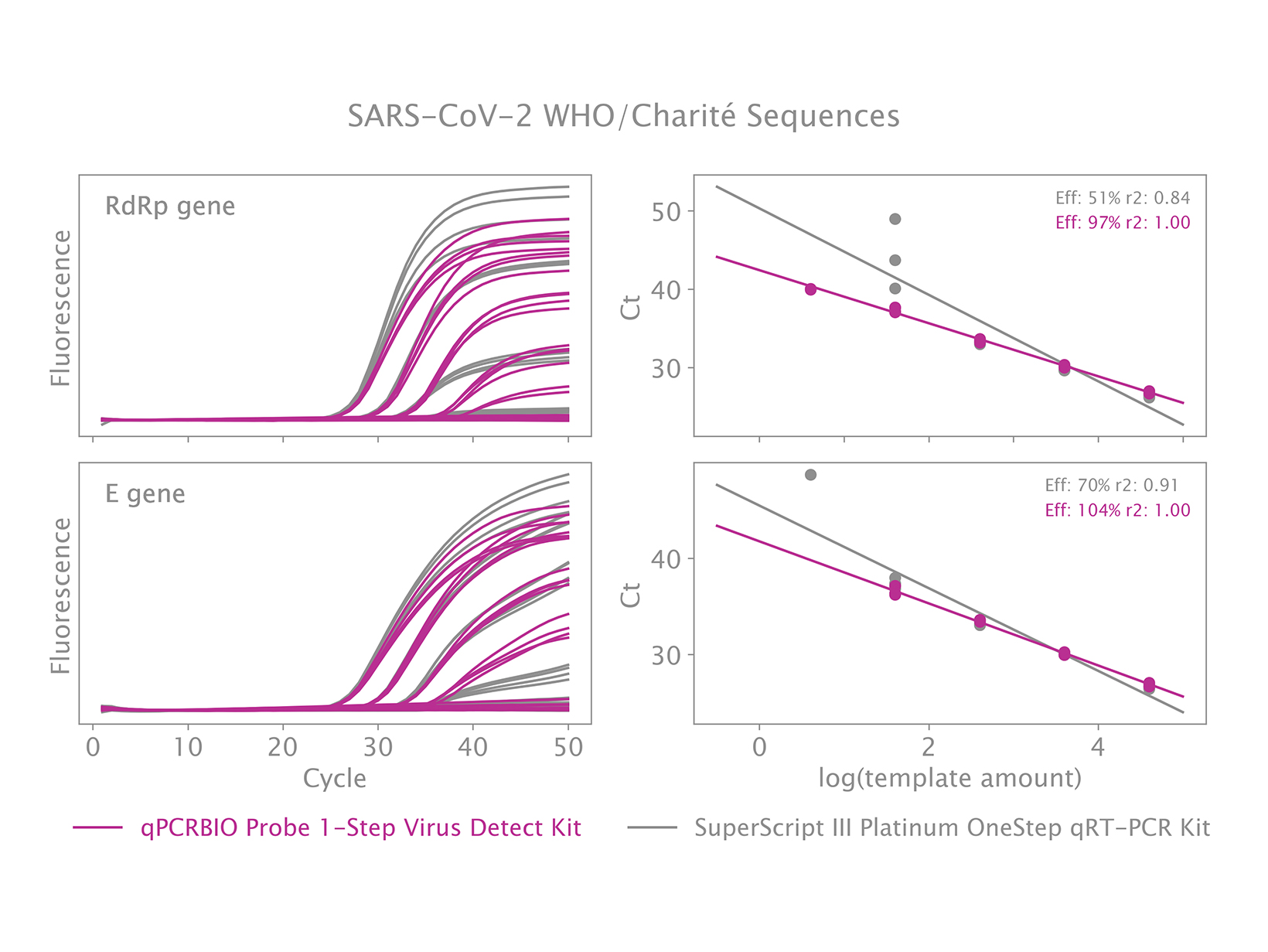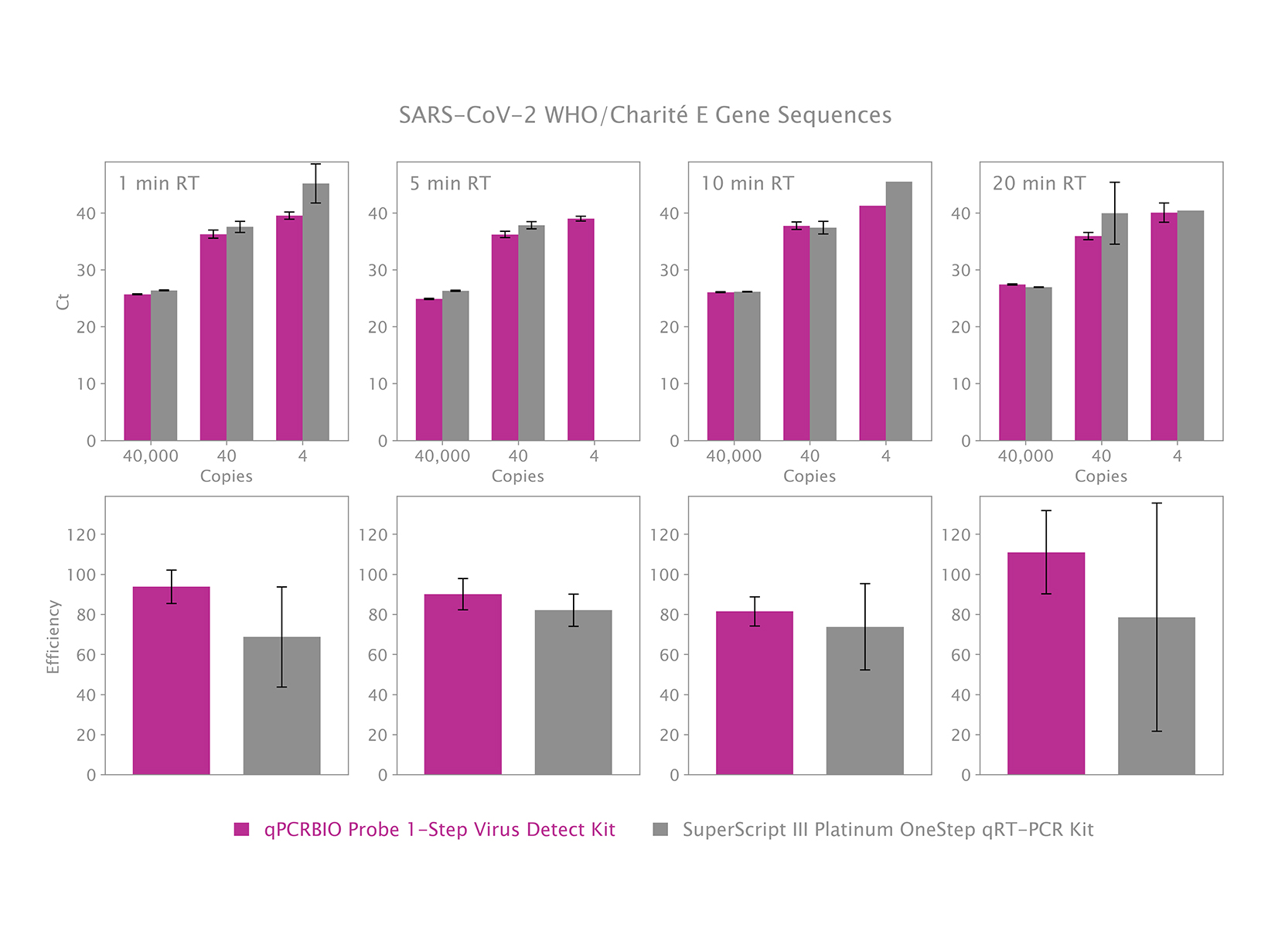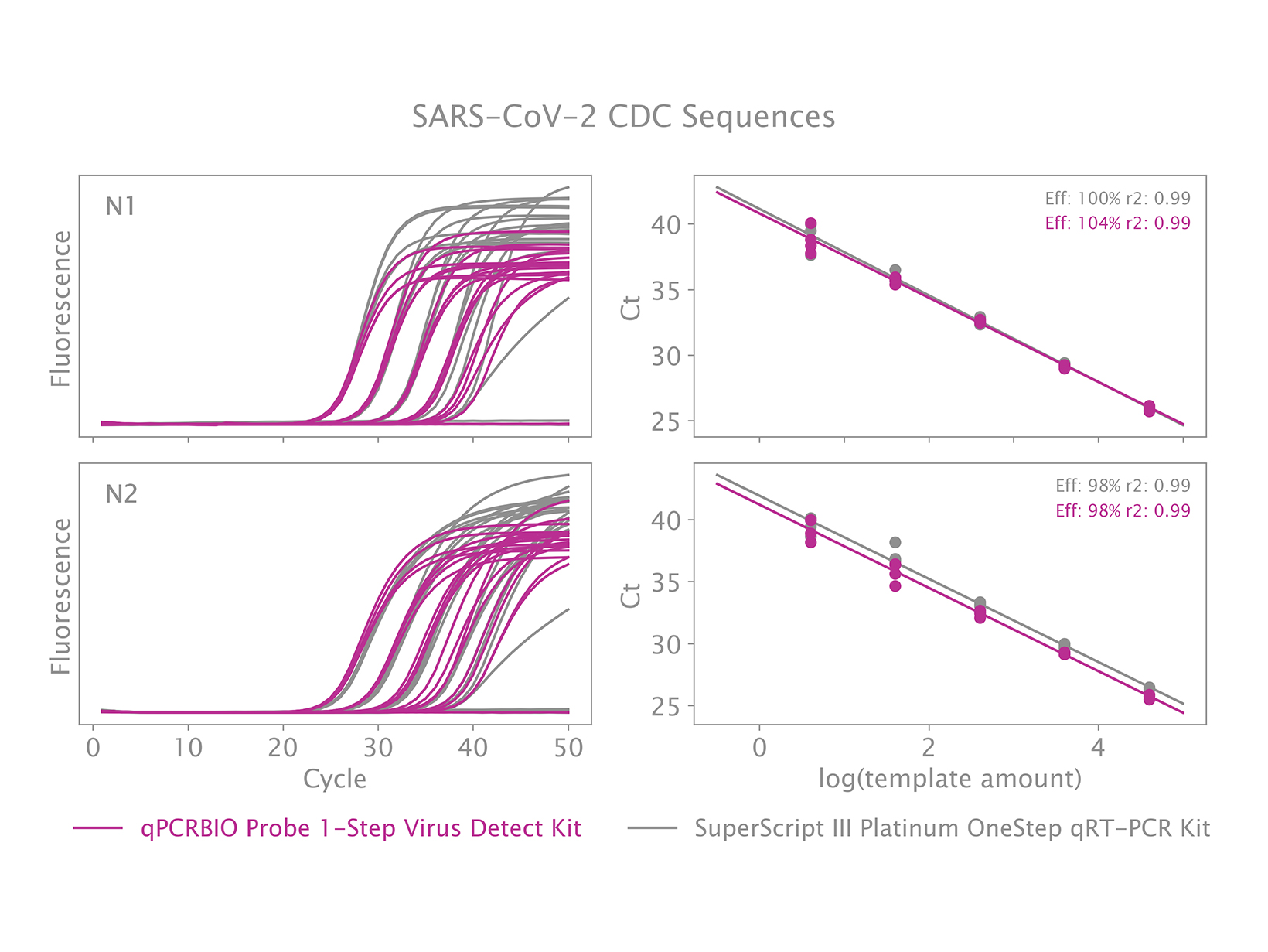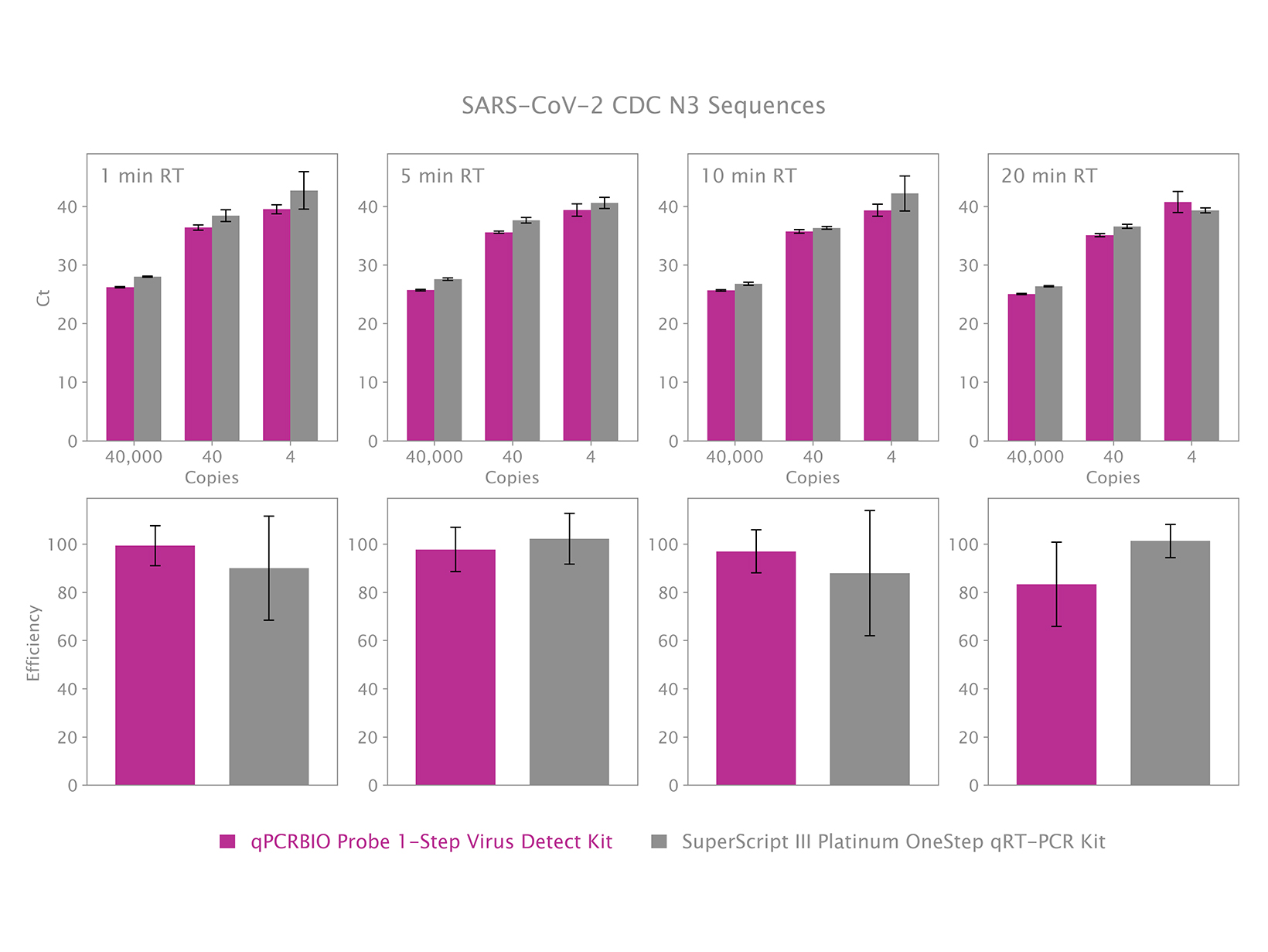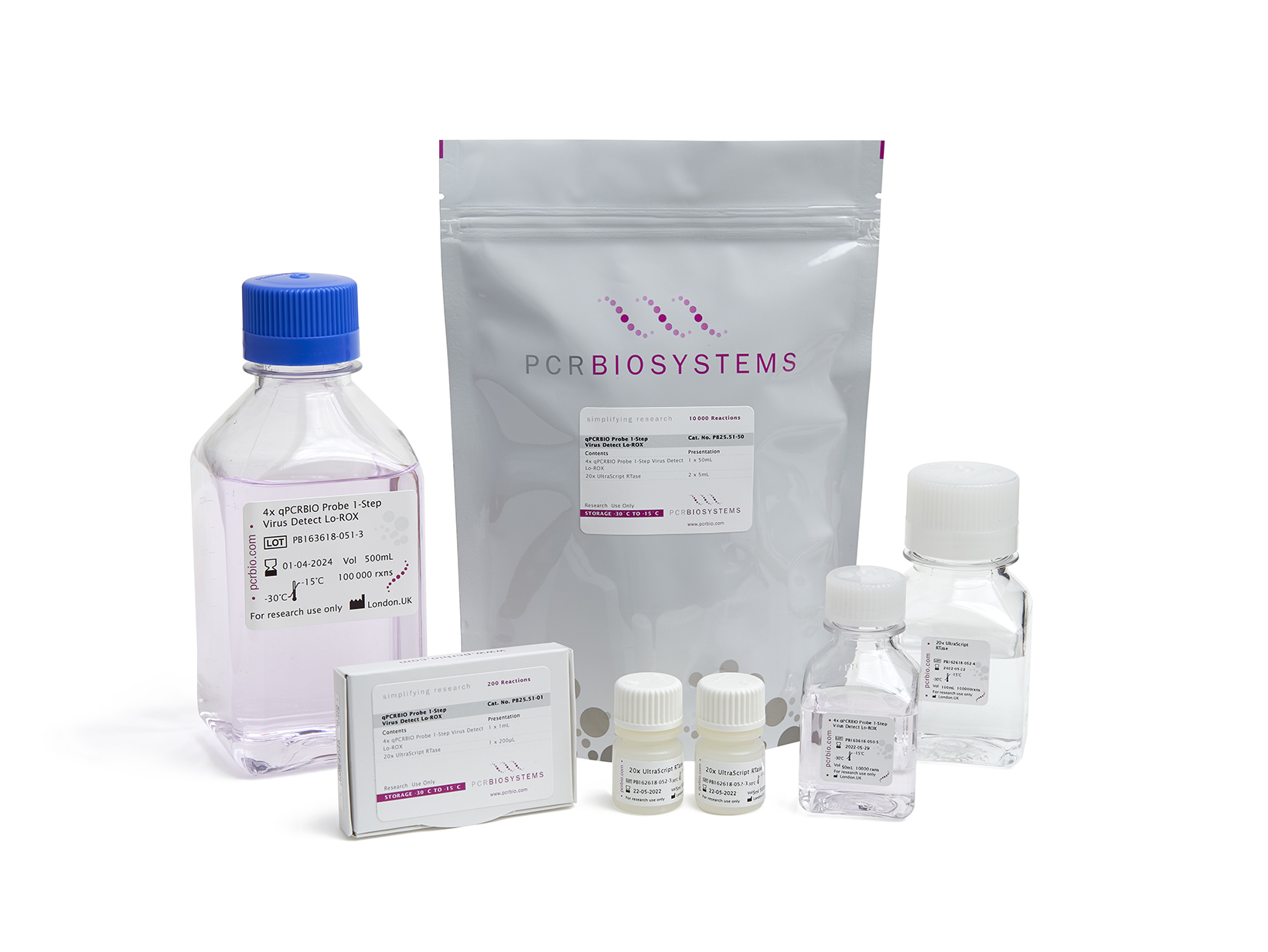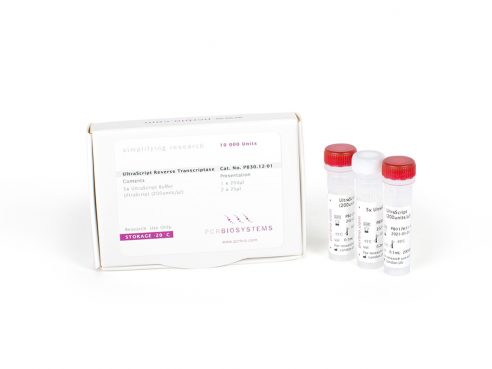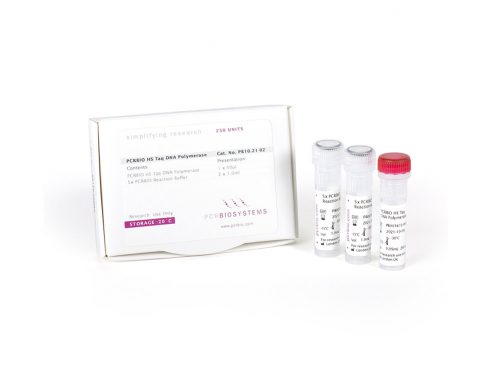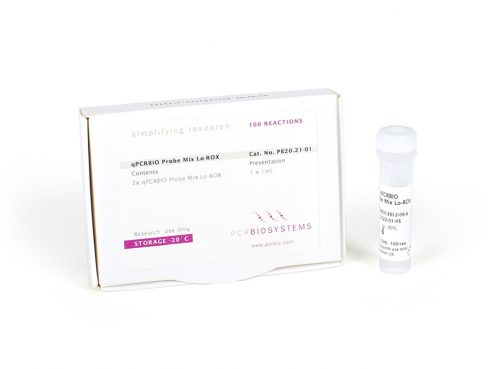To view your price please login or contact us
qPCRBIO Probe 1-Step Virus Detect
qPCRBIO Probe 1-Step Virus Detect is designed for ultra-sensitive detection of viral RNA by 1-step RT-qPCR using sequence-specific probes.
The kit has been optimised with a high-concentration 4x mix, enabling greater sample input and increasing sensitivity, even when working with small volume reactions.
Features
- Recommended kit for SARS-CoV-2 diagnostics
- Validated for qualitative detection of SARS-CoV-2 nucleic acid
- Concentrated 4x mix format, ideal for high-throughput, highly multiplexed assays
- Ultra-sensitive detection of RNA viruses
- Earlier detection of a wide range of template amounts
- Includes UltraScript RTase for thermostable reverse transcription up to 55°C
- Advanced RNase inhibitor
- Antibody-mediated hot start technology
- Compatible with all real-time PCR platforms – standard and fast cycling conditions
More Information
qPCRBIO Probe 1-Step Virus Detect is designed for ultra-sensitive detection of viral RNA by reverse transcription real-time PCR (RT-qPCR) using sequence-specific probes. The kit contains proprietary components that are optimised to enable cDNA synthesis and PCR amplification to be performed in a single tube.
High sensitivity
Developed with a high concentration 4x mix format, qPCRBIO Probe 1-Step Virus Detect offers greater sensitivity and flexibility by allowing more sample to be added to each reaction, and for smaller reaction volumes to be used with confidence. This is particularly beneficial in high throughput assays or for clinical diagnostic testing where accurate and reproducible detection of low copy viral templates is of crucial importance. This specialised kit allows accurate and sensitive detection of viral sequences over a broad range of input RNA, down to 4 copies tested per reaction (0.8 copies per μL).
Robust and reproducible RT-qPCR
Fast and efficient cDNA synthesis is provided by UltraScript Reverse Transcriptase, which can operate over a wide range of reaction temperatures. Reverse transcription can be performed in only 5 minutes and at temperatures up to 55°C, enhancing detection of GC-rich and highly structured viral RNA sequences. The PCR step is powered by PCRBIO HS Taq DNA Polymerase, which employs antibody-mediated hot start technology for specific amplification of virus-derived cDNA, with improved tolerance to common PCR inhibitors. Combined with a specially formulated buffer system developed using proprietary smart screen technology, qPCRBIO Probe 1-Step Virus Detect gives robust and reproducible RT-qPCR while minimising the potential for primer dimer and other non-specific products.
SARS-CoV-2 detection
qPCRBIO Probe 1-Step Virus Detect comes ready-optimised and validated for qualitative detection of SARS-CoV-2 nucleic acid and is ideally suited to high throughput testing of COVID-19 clinical samples, either by laboratory developed assays or as a component of diagnostic testing kits. Validation has been performed using the Charité (Berlin, Germany) recommended primer-probe sequences (RdRp and E genes), and Centers for Disease Control and Prevention (Atlanta, USA) primer-probe sequences (N gene).
Universal detection kit
qPCRBIO Probe 1-Step Virus Detect contains all the required components for accurate and sensitive RT-qPCR except for primers, probe, RNA template and water. For maximum flexibility the kit is engineered for use on a wide range of probe technologies, including TaqMan®, Scorpions® and molecular beacon probes. It can be used with RNA extracted by most commercial kits, provided the amount and quality of template RNA are within an acceptable range. The kit is compatible with multiplexing assays and with all real-time PCR platforms. Use our qPCR Selection Tool to find out which ROX variant is compatible with your instrument.
This product alone does not provide any diagnostic result and is supplied for Research Use Only. It is suitable for use as a component of molecular diagnostic assays, where applicable country laws allow.
Applications
- COVID-19 / SARS-CoV-2 diagnostics and research
- RNA virus detection
- Diagnostic real-time PCR
- Detection of extremely low copy number targets
- High throughput assays
- Singleplex and multiplex
- TaqMan®, Scorpions® and molecular beacon probes
Specifications
qPCRBIO Probe 1-Step Virus Detect Lo-ROX
Component
200 Reactions
600 Reactions
1000 Reactions
10,000 Reactions
100,000 Reactions
4x qPCRBIO Probe 1-Step Virus Detect Lo-ROX
1 x 1mL
3 x 1mL
1 x 5mL
1 x 50mL
1 x 500mL
20x UltraScript RTase (with RNase inhibitor)
1 x 200μL
1 x 600μL
1 x 1mL
2 x 5mL
1 x 100mL
qPCRBIO Probe 1-Step Virus Detect Hi-ROX
Component
200 Reactions
600 Reactions
1000 Reactions
10,000 Reactions
100,000 Reactions
4x qPCRBIO Probe 1-Step Virus Detect Hi-ROX
1 x 1mL
3 x 1mL
1 x 5mL
1 x 50mL
1 x 500mL
20x UltraScript RTase (with RNase inhibitor)
1 x 200μL
1 x 600μL
1 x 1mL
2 x 5mL
1 x 100mL
qPCRBIO Probe 1-Step Virus Detect No-ROX
Component
200 Reactions
600 Reactions
1000 Reactions
10,000 Reactions
100,000 Reactions
4x qPCRBIO Probe 1-Step Virus Detect No-ROX
1 x 1mL
3 x 1mL
1 x 5mL
1 x 50mL
1 x 500mL
20x UltraScript RTase (with RNase inhibitor)
1 x 200μL
1 x 600μL
1 x 1mL
2 x 5mL
1 x 100mL
qPCRBIO Probe 1-Step Virus Detect Separate-ROX
Component
200 Reactions
600 Reactions
1000 Reactions
4x qPCRBIO Probe 1-Step Virus Detect No-ROX
1 x 1mL
3 x 1mL
1 x 5mL
20x UltraScript RTase (with RNase inhibitor)
1 x 200μL
1 x 600μL
1 x 1mL
50μM ROX Additive
1 x 200μL
1 x 200μL
1 x 200μL
qPCRBIO Probe 1-Step Virus Detect Lo-ROX
Component
4x qPCRBIO Probe 1-Step Virus Detect Lo-ROX
20x UltraScript RTase (with RNase inhibitor)
200 Reactions
1 x 1mL
1 x 200μL
600 Reactions
3 x 1mL
1 x 600μL
1000 Reactions
1 x 5mL
1 x 1mL
10,000 Reactions
1 x 50mL
2 x 5mL
100,000 Reactions
1 x 500mL
1 x 100mL
qPCRBIO Probe 1-Step Virus Detect Hi-ROX
Component
4x qPCRBIO Probe 1-Step Virus Detect Hi-ROX
20x UltraScript RTase (with RNase inhibitor)
200 Reactions
1 x 1mL
1 x 200μL
600 Reactions
3 x 1mL
1 x 600μL
1000 Reactions
1 x 5mL
1 x 1mL
10,000 Reactions
1 x 50mL
2 x 5mL
100,000 Reactions
1 x 500mL
1 x 100mL
qPCRBIO Probe 1-Step Virus Detect No-ROX
Component
4x qPCRBIO Probe 1-Step Virus Detect No-ROX
20x UltraScript RTase (with RNase inhibitor)
200 Reactions
1 x 1mL
1 x 200μL
600 Reactions
3 x 1mL
1 x 600μL
1000 Reactions
1 x 5mL
1 x 1mL
10,000 Reactions
1 x 50mL
2 x 5mL
100,000 Reactions
1 x 500mL
1 x 100mL
qPCRBIO Probe 1-Step Virus Detect Separate-ROX
Component
4x qPCRBIO Probe 1-Step Virus Detect No-ROX
20x UltraScript RTase (with RNase inhibitor)
50μM ROX Additive
200 Reactions
1 x 1mL
1 x 200μL
1 x 200μL
600 Reactions
3 x 1mL
1 x 600μL
1 x 200μL
1000 Reactions
1 x 5mL
1 x 1mL
1 x 200μL
Reaction Volume
Storage
20μL
On arrival, products should be stored between -30 and -15°C. If stored correctly the kit will retain full activity for 12 months.
Reaction Volume
20μL
Storage
On arrival, products should be stored between -30 and -15°C. If stored correctly the kit will retain full activity for 12 months.
Instrument Compatibility
This product is compatible with all standard and fast cycling qPCR instruments. Use our qPCR Selection Tool to find out which ROX variant is compatible with your instrument.
Documents
Product Flyers
Product Manuals
Material Safety Data Sheets
Application Notes
Certificate of Analysis Finder
FAQs
Beyond what Ct value are results unreliable?
Ct values can vary between template concentrations, reaction optimisation, instruments and laboratories so care must be taken when selecting a cut-off Ct value. Generally, Ct values over 35 would begin to be considered unreliable. However, late Cts could be observed for inefficient reactions using low template copy number. It is always good practice to normalise cut-offs with relative or absolute quantification methods. It is also recommended to run and analyse melt curves or gels of the products to determine products of any late amplifications
Can ROX have a negative impact on the reaction?
ROX (6-carboxy-X-rhodamine) is used as a passive reference dye in ROX-dependent real-time PCR instruments to normalize for variations of fluorescence levels that can arise mainly due to optical path variations among wells. Normalisation of the fluorescence intensity (Rn) is done in real-time PCR software by dividing the emission intensity of the specific signal by the emission intensity of ROX.
ROX does not take part in the PCR reaction and its fluorescence levels are not proportional to the quantity of DNA in each well, so the addition of this fluorophore to a mix provides a constant fluorescent signal during amplification.
Different types of real-time PCR instruments requiring a passive reference standard have different optimal concentrations of ROX, mainly due to the different optical configurations of each system (i.e. the different type of excitation source and optics used).
The addition of either too little or too much ROX would result in a very noisy signal impacting on the results of the reaction. Therefore, it is extremely important for the user to:
- Determine the correct ROX concentration to optimise real-time PCR results, and
- Check the ROX settings on the software used to set up the reaction
A useful selection tool for the most commonly used systems can be found here.
Can the activation time for the HS Taq DNA Polymerase be altered?
We recommend using a minimum of 2 minutes for activating the polymerase. Longer times of up to 15 minutes can also be used with no detrimental effects to the enzyme.
Do I need 1-step or 2-step reaction?
1-step
Both the cDNA synthesis and PCR reactions occur in the same mix. This option is suited for high throughput applications due to its speed and ease of set up. There is also a reduced risk of contamination. It is not ideal for low quality RNA samples or if the cDNA is required for archive or separate analysis.
2-step
The cDNA synthesis and PCR reactions occur separately. This option is better suited if the cDNA product needs to be retained for analysis. It also allows for higher levels of reaction optimisation. It permits control over the type and concentration of enzyme, RNA input and concentration of cDNA which, in turn, results in higher sensitivity compared to the 1-step format.
Do I need to use an RNase inhibitor in my RT reaction?
No, the 20x UltraScript RTase contains an RNase inhibitor to prevent any degradation and increase sensitivity.
General troubleshooting for low product or late Ct values
If you are observing unusually late Ct values, try diluting the template RNA. By doing this, you are diluting any inhibitors which may be present to a concentration where they do not inhibit the reaction. Additionally, try increasing the reverse transcription step to 55 °C and increasing the annealing/extension temperatures. This may help resolve difficulties caused by secondary structures present in the RNA template and/or primers.
In cases where reaction inhibition may be involved, try reducing the amount of template1 or add 0.4 – 4.4 mg/ml BSA to the reaction2.
For more specific problems contact [email protected] with the following information:
- Amplicon size
- Reaction setup
- Cycling conditions
- Screen grabs of amplification traces and melting profile
1 Scipioni et al. A SYBR Green RT-PCR assay in single tube to detect human and bovine noroviruses and control for inhibition. Virology Journal.5:94 (2008). doi: 1186/1743-422X-5-94
2 Plante et al. The use of bovine serum albumin to improve the RT‐qPCR detection of foodborne viruses rinsed from vegetable surfaces. Applied Microbiology. 52:3 (2010) doi: https://doi.org/10.1111/j.1472-765X.2010.02989.x
Is it normal if the fluorescence of qPCRBIO Probe Mixes differs from the one obtained with competitors’ products?
Different products could give a different plateau of fluorescence. However, this has no impact on quantification accuracy and Ct values will not differ among products.
What are the differences between probe and dye-based mixes?
Probe based kits such as qPCRBIO Probe 1-Step Virus Detect offer higher sensitivity and are unlikely to show non-template amplifications. Multiplexes can be measured using amplicons with different fluorophores for specific probes, which cannot be achieved using dyes.
Dye-based systems such as qPCRBIO SyGreen 1-Step Detect and 1-Step Go detect any intact dsDNA and will therefore show primer dimers and off-target/non-template amplifications. These can be separated from product peaks by analysing melting curves.
What is ROX and do I need it?
ROX is a passive reference dye which means it does not take part in the PCR reaction. It is used to normalise non-PCR related fluctuations in fluorescence. You can use our qPCR Selection Tool in the Resources section to determine which of our qPCR mixes are best suited for your qPCR machine.
What is the MgCl2 concentration in qPCRBIO Probe 1-Step Virus Detect mixes?
All 4x qPCRBIO Probe 1-Step Virus Detect mixes contain MgCl2 at a concentration of 18 mM. This means the final concentration in the reaction is 4.5 mM.
What priming method can I use?
Gene specific primers can be used in the 1-step reaction.
What should be considered when doing multiplex amplification with qPCRBIO Probe 1-Step Virus Detect?
The primers should be designed to ensure that they have similar annealing temperatures, are specific to the target, and do not form primer dimers. The length of the reverse transcription phase can be extended to 10 minutes to ensure there is enough template for priming and amplification.
When performing a multiplex, what is the recommended concentration of each primer?
We recommend using 400-1000 nM of each primer. There is a degree of flexibility around this recommended concentration, however the primer concentration should not be increased beyond this range as this may significantly affect the activity of the enzyme.
More Information
qPCRBIO Probe 1-Step Virus Detect is designed for ultra-sensitive detection of viral RNA by reverse transcription real-time PCR (RT-qPCR) using sequence-specific probes. The kit contains proprietary components that are optimised to enable cDNA synthesis and PCR amplification to be performed in a single tube.
High sensitivity
Developed with a high concentration 4x mix format, qPCRBIO Probe 1-Step Virus Detect offers greater sensitivity and flexibility by allowing more sample to be added to each reaction, and for smaller reaction volumes to be used with confidence. This is particularly beneficial in high throughput assays or for clinical diagnostic testing where accurate and reproducible detection of low copy viral templates is of crucial importance. This specialised kit allows accurate and sensitive detection of viral sequences over a broad range of input RNA, down to 4 copies tested per reaction (0.8 copies per μL).
Robust and reproducible RT-qPCR
Fast and efficient cDNA synthesis is provided by UltraScript Reverse Transcriptase, which can operate over a wide range of reaction temperatures. Reverse transcription can be performed in only 5 minutes and at temperatures up to 55°C, enhancing detection of GC-rich and highly structured viral RNA sequences. The PCR step is powered by PCRBIO HS Taq DNA Polymerase, which employs antibody-mediated hot start technology for specific amplification of virus-derived cDNA, with improved tolerance to common PCR inhibitors. Combined with a specially formulated buffer system developed using proprietary smart screen technology, qPCRBIO Probe 1-Step Virus Detect gives robust and reproducible RT-qPCR while minimising the potential for primer dimer and other non-specific products.
SARS-CoV-2 detection
qPCRBIO Probe 1-Step Virus Detect comes ready-optimised and validated for qualitative detection of SARS-CoV-2 nucleic acid and is ideally suited to high throughput testing of COVID-19 clinical samples, either by laboratory developed assays or as a component of diagnostic testing kits. Validation has been performed using the Charité (Berlin, Germany) recommended primer-probe sequences (RdRp and E genes), and Centers for Disease Control and Prevention (Atlanta, USA) primer-probe sequences (N gene).
Universal detection kit
qPCRBIO Probe 1-Step Virus Detect contains all the required components for accurate and sensitive RT-qPCR except for primers, probe, RNA template and water. For maximum flexibility the kit is engineered for use on a wide range of probe technologies, including TaqMan®, Scorpions® and molecular beacon probes. It can be used with RNA extracted by most commercial kits, provided the amount and quality of template RNA are within an acceptable range. The kit is compatible with multiplexing assays and with all real-time PCR platforms. Use our qPCR Selection Tool to find out which ROX variant is compatible with your instrument.
This product alone does not provide any diagnostic result and is supplied for Research Use Only. It is suitable for use as a component of molecular diagnostic assays, where applicable country laws allow.
Applications
- COVID-19 / SARS-CoV-2 diagnostics and research
- RNA virus detection
- Diagnostic real-time PCR
- Detection of extremely low copy number targets
- High throughput assays
- Singleplex and multiplex
- TaqMan®, Scorpions® and molecular beacon probes
Specifications
qPCRBIO Probe 1-Step Virus Detect Lo-ROX
Component
200 Reactions
600 Reactions
1000 Reactions
10,000 Reactions
100,000 Reactions
4x qPCRBIO Probe 1-Step Virus Detect Lo-ROX
1 x 1mL
3 x 1mL
1 x 5mL
1 x 50mL
1 x 500mL
20x UltraScript RTase (with RNase inhibitor)
1 x 200μL
1 x 600μL
1 x 1mL
2 x 5mL
1 x 100mL
qPCRBIO Probe 1-Step Virus Detect Hi-ROX
Component
200 Reactions
600 Reactions
1000 Reactions
10,000 Reactions
100,000 Reactions
4x qPCRBIO Probe 1-Step Virus Detect Hi-ROX
1 x 1mL
3 x 1mL
1 x 5mL
1 x 50mL
1 x 500mL
20x UltraScript RTase (with RNase inhibitor)
1 x 200μL
1 x 600μL
1 x 1mL
2 x 5mL
1 x 100mL
qPCRBIO Probe 1-Step Virus Detect No-ROX
Component
200 Reactions
600 Reactions
1000 Reactions
10,000 Reactions
100,000 Reactions
4x qPCRBIO Probe 1-Step Virus Detect No-ROX
1 x 1mL
3 x 1mL
1 x 5mL
1 x 50mL
1 x 500mL
20x UltraScript RTase (with RNase inhibitor)
1 x 200μL
1 x 600μL
1 x 1mL
2 x 5mL
1 x 100mL
qPCRBIO Probe 1-Step Virus Detect Separate-ROX
Component
200 Reactions
600 Reactions
1000 Reactions
4x qPCRBIO Probe 1-Step Virus Detect No-ROX
1 x 1mL
3 x 1mL
1 x 5mL
20x UltraScript RTase (with RNase inhibitor)
1 x 200μL
1 x 600μL
1 x 1mL
50μM ROX Additive
1 x 200μL
1 x 200μL
1 x 200μL
qPCRBIO Probe 1-Step Virus Detect Lo-ROX
Component
4x qPCRBIO Probe 1-Step Virus Detect Lo-ROX
20x UltraScript RTase (with RNase inhibitor)
200 Reactions
1 x 1mL
1 x 200μL
600 Reactions
3 x 1mL
1 x 600μL
1000 Reactions
1 x 5mL
1 x 1mL
10,000 Reactions
1 x 50mL
2 x 5mL
100,000 Reactions
1 x 500mL
1 x 100mL
qPCRBIO Probe 1-Step Virus Detect Hi-ROX
Component
4x qPCRBIO Probe 1-Step Virus Detect Hi-ROX
20x UltraScript RTase (with RNase inhibitor)
200 Reactions
1 x 1mL
1 x 200μL
600 Reactions
3 x 1mL
1 x 600μL
1000 Reactions
1 x 5mL
1 x 1mL
10,000 Reactions
1 x 50mL
2 x 5mL
100,000 Reactions
1 x 500mL
1 x 100mL
qPCRBIO Probe 1-Step Virus Detect No-ROX
Component
4x qPCRBIO Probe 1-Step Virus Detect No-ROX
20x UltraScript RTase (with RNase inhibitor)
200 Reactions
1 x 1mL
1 x 200μL
600 Reactions
3 x 1mL
1 x 600μL
1000 Reactions
1 x 5mL
1 x 1mL
10,000 Reactions
1 x 50mL
2 x 5mL
100,000 Reactions
1 x 500mL
1 x 100mL
qPCRBIO Probe 1-Step Virus Detect Separate-ROX
Component
4x qPCRBIO Probe 1-Step Virus Detect No-ROX
20x UltraScript RTase (with RNase inhibitor)
50μM ROX Additive
200 Reactions
1 x 1mL
1 x 200μL
1 x 200μL
600 Reactions
3 x 1mL
1 x 600μL
1 x 200μL
1000 Reactions
1 x 5mL
1 x 1mL
1 x 200μL
Reaction Volume
Storage
20μL
On arrival, products should be stored between -30 and -15°C. If stored correctly the kit will retain full activity for 12 months.
Reaction Volume
20μL
Storage
On arrival, products should be stored between -30 and -15°C. If stored correctly the kit will retain full activity for 12 months.
Instrument Compatibility
This product is compatible with all standard and fast cycling qPCR instruments. Use our qPCR Selection Tool to find out which ROX variant is compatible with your instrument.
Documents
Product Flyers
Product Manuals
Material Safety Data Sheets
Application Notes
Certificate of Analysis Finder
FAQs
Beyond what Ct value are results unreliable?
Ct values can vary between template concentrations, reaction optimisation, instruments and laboratories so care must be taken when selecting a cut-off Ct value. Generally, Ct values over 35 would begin to be considered unreliable. However, late Cts could be observed for inefficient reactions using low template copy number. It is always good practice to normalise cut-offs with relative or absolute quantification methods. It is also recommended to run and analyse melt curves or gels of the products to determine products of any late amplifications
Can ROX have a negative impact on the reaction?
ROX (6-carboxy-X-rhodamine) is used as a passive reference dye in ROX-dependent real-time PCR instruments to normalize for variations of fluorescence levels that can arise mainly due to optical path variations among wells. Normalisation of the fluorescence intensity (Rn) is done in real-time PCR software by dividing the emission intensity of the specific signal by the emission intensity of ROX.
ROX does not take part in the PCR reaction and its fluorescence levels are not proportional to the quantity of DNA in each well, so the addition of this fluorophore to a mix provides a constant fluorescent signal during amplification.
Different types of real-time PCR instruments requiring a passive reference standard have different optimal concentrations of ROX, mainly due to the different optical configurations of each system (i.e. the different type of excitation source and optics used).
The addition of either too little or too much ROX would result in a very noisy signal impacting on the results of the reaction. Therefore, it is extremely important for the user to:
- Determine the correct ROX concentration to optimise real-time PCR results, and
- Check the ROX settings on the software used to set up the reaction
A useful selection tool for the most commonly used systems can be found here.
Can the activation time for the HS Taq DNA Polymerase be altered?
We recommend using a minimum of 2 minutes for activating the polymerase. Longer times of up to 15 minutes can also be used with no detrimental effects to the enzyme.
Do I need 1-step or 2-step reaction?
1-step
Both the cDNA synthesis and PCR reactions occur in the same mix. This option is suited for high throughput applications due to its speed and ease of set up. There is also a reduced risk of contamination. It is not ideal for low quality RNA samples or if the cDNA is required for archive or separate analysis.
2-step
The cDNA synthesis and PCR reactions occur separately. This option is better suited if the cDNA product needs to be retained for analysis. It also allows for higher levels of reaction optimisation. It permits control over the type and concentration of enzyme, RNA input and concentration of cDNA which, in turn, results in higher sensitivity compared to the 1-step format.
Do I need to use an RNase inhibitor in my RT reaction?
No, the 20x UltraScript RTase contains an RNase inhibitor to prevent any degradation and increase sensitivity.
General troubleshooting for low product or late Ct values
If you are observing unusually late Ct values, try diluting the template RNA. By doing this, you are diluting any inhibitors which may be present to a concentration where they do not inhibit the reaction. Additionally, try increasing the reverse transcription step to 55 °C and increasing the annealing/extension temperatures. This may help resolve difficulties caused by secondary structures present in the RNA template and/or primers.
In cases where reaction inhibition may be involved, try reducing the amount of template1 or add 0.4 – 4.4 mg/ml BSA to the reaction2.
For more specific problems contact [email protected] with the following information:
- Amplicon size
- Reaction setup
- Cycling conditions
- Screen grabs of amplification traces and melting profile
1 Scipioni et al. A SYBR Green RT-PCR assay in single tube to detect human and bovine noroviruses and control for inhibition. Virology Journal.5:94 (2008). doi: 1186/1743-422X-5-94
2 Plante et al. The use of bovine serum albumin to improve the RT‐qPCR detection of foodborne viruses rinsed from vegetable surfaces. Applied Microbiology. 52:3 (2010) doi: https://doi.org/10.1111/j.1472-765X.2010.02989.x
Is it normal if the fluorescence of qPCRBIO Probe Mixes differs from the one obtained with competitors’ products?
Different products could give a different plateau of fluorescence. However, this has no impact on quantification accuracy and Ct values will not differ among products.
What are the differences between probe and dye-based mixes?
Probe based kits such as qPCRBIO Probe 1-Step Virus Detect offer higher sensitivity and are unlikely to show non-template amplifications. Multiplexes can be measured using amplicons with different fluorophores for specific probes, which cannot be achieved using dyes.
Dye-based systems such as qPCRBIO SyGreen 1-Step Detect and 1-Step Go detect any intact dsDNA and will therefore show primer dimers and off-target/non-template amplifications. These can be separated from product peaks by analysing melting curves.
What is ROX and do I need it?
ROX is a passive reference dye which means it does not take part in the PCR reaction. It is used to normalise non-PCR related fluctuations in fluorescence. You can use our qPCR Selection Tool in the Resources section to determine which of our qPCR mixes are best suited for your qPCR machine.
What is the MgCl2 concentration in qPCRBIO Probe 1-Step Virus Detect mixes?
All 4x qPCRBIO Probe 1-Step Virus Detect mixes contain MgCl2 at a concentration of 18 mM. This means the final concentration in the reaction is 4.5 mM.
What priming method can I use?
Gene specific primers can be used in the 1-step reaction.
What should be considered when doing multiplex amplification with qPCRBIO Probe 1-Step Virus Detect?
The primers should be designed to ensure that they have similar annealing temperatures, are specific to the target, and do not form primer dimers. The length of the reverse transcription phase can be extended to 10 minutes to ensure there is enough template for priming and amplification.
When performing a multiplex, what is the recommended concentration of each primer?
We recommend using 400-1000 nM of each primer. There is a degree of flexibility around this recommended concentration, however the primer concentration should not be increased beyond this range as this may significantly affect the activity of the enzyme.




